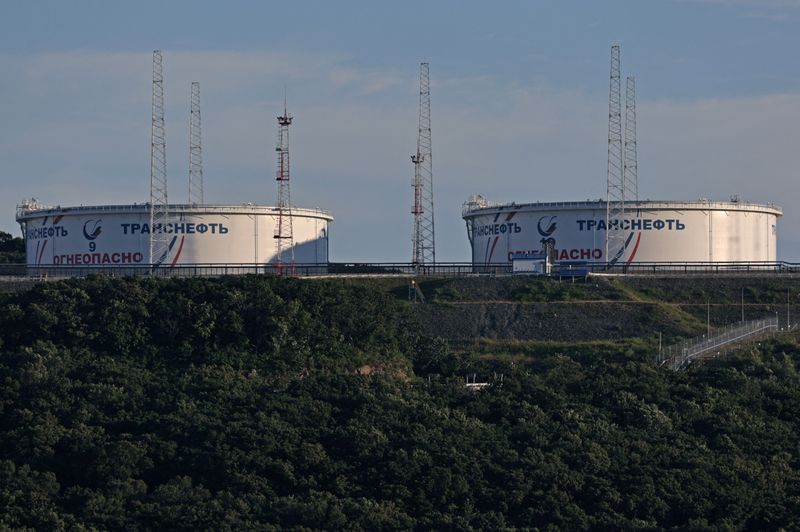Commodities
Oil ends lower, posts weekly decline as US rate cut hopes dim


© Reuters. FILE PHOTO: A view shows oil tanks of Transneft oil pipeline operator at the crude oil terminal Kozmino on the shore of Nakhodka Bay near the port city of Nakhodka, Russia August 12, 2022. REUTERS/Tatiana Meel/File Photo
By Nicole Jao
NEW YORK (Reuters) -Oil prices fell nearly 3% lower on Friday and posted a weekly decline after a U.S. central bank policymaker indicated interest rate cuts could be delayed by at least two more months.
futures settled down $2.05, or 2.5%, at $81.62 a barrel, while U.S. West Texas Intermediate crude futures (WTI) were down $2.12, or 2.7%, to $76.49.
For the week, Brent declined about 2% and WTI fell more than 3%. However, indications of healthy fuel demand and supply concerns could revive prices in the coming days.
Federal Reserve policymakers should delay U.S. interest rate cuts by at least another couple of months, Fed Governor Christopher Waller said on Thursday, which could slow economic growth and curb oil demand.
The Fed has held its policy rate steady in a 5.25% to 5.5% range since last July. Minutes of its meeting last month show most central bankers were worried about moving too quickly to ease policy.
“The entire energy complex is reacting, because if inflation begins to come back it will slow demand for energy products,” said Tim Snyder, economist at Matador Economics.
“That is not something the market wants to digest right now, especially as it is trying to figure out a direction,” he added.
Some analysts, however, say demand has remained largely healthy despite the impact of high interest rates, including in the United States.
JPMorgan’s demand indicators are showing oil demand rising by 1.7 million barrels per day (bpd) month over month through Feb. 21, its analysts said in a note.
“This compares to a 1.6 million bpd increase observed during the prior week, likely benefiting from increased travel demand in China and Europe,” the analysts said.
Meanwhile, Gaza truce talks were underway in Paris in what appears to be the most serious push in weeks to halt the conflict in Palestine and see Israeli and foreign hostages released.
Ceasefire talks could prompt the market to anticipate an easing of geopolitical tensions, Tim Evans, an independent oil market analyst, said in a note.
Still, tensions in the Red Sea continued, with attacks by Iran-backed Houthi militants near Yemen on Thursday forcing more shipping vessels to divert from the trade route.
U.S. energy firms this week added the most oil rigs since November, and the most in a month since October 2022, energy services firm Baker Hughes said.
The oil rig count, an early indicator of future output, rose by six to 503 this week, and increased by four this month.
Commodities
Oil prices rise; U.S. crude inventories plunge, Russia-Ukraine truce eyed
Commodities
India’s Reliance to stop buying Venezuelan oil over US tariffs, sources say
Commodities
Oil prices climb on Venezuela supply worries

 Forex3 years ago
Forex3 years agoForex Today: the dollar is gaining strength amid gloomy sentiment at the start of the Fed’s week

 Forex3 years ago
Forex3 years agoUnbiased review of Pocket Option broker

 Forex3 years ago
Forex3 years agoDollar to pound sterling exchange rate today: Pound plummeted to its lowest since 1985

 Forex3 years ago
Forex3 years agoHow is the Australian dollar doing today?

 Cryptocurrency3 years ago
Cryptocurrency3 years agoWhat happened in the crypto market – current events today

 World3 years ago
World3 years agoWhy are modern video games an art form?

 Commodities3 years ago
Commodities3 years agoCopper continues to fall in price on expectations of lower demand in China

 Economy3 years ago
Economy3 years agoCrude oil tankers double in price due to EU anti-Russian sanctions



























